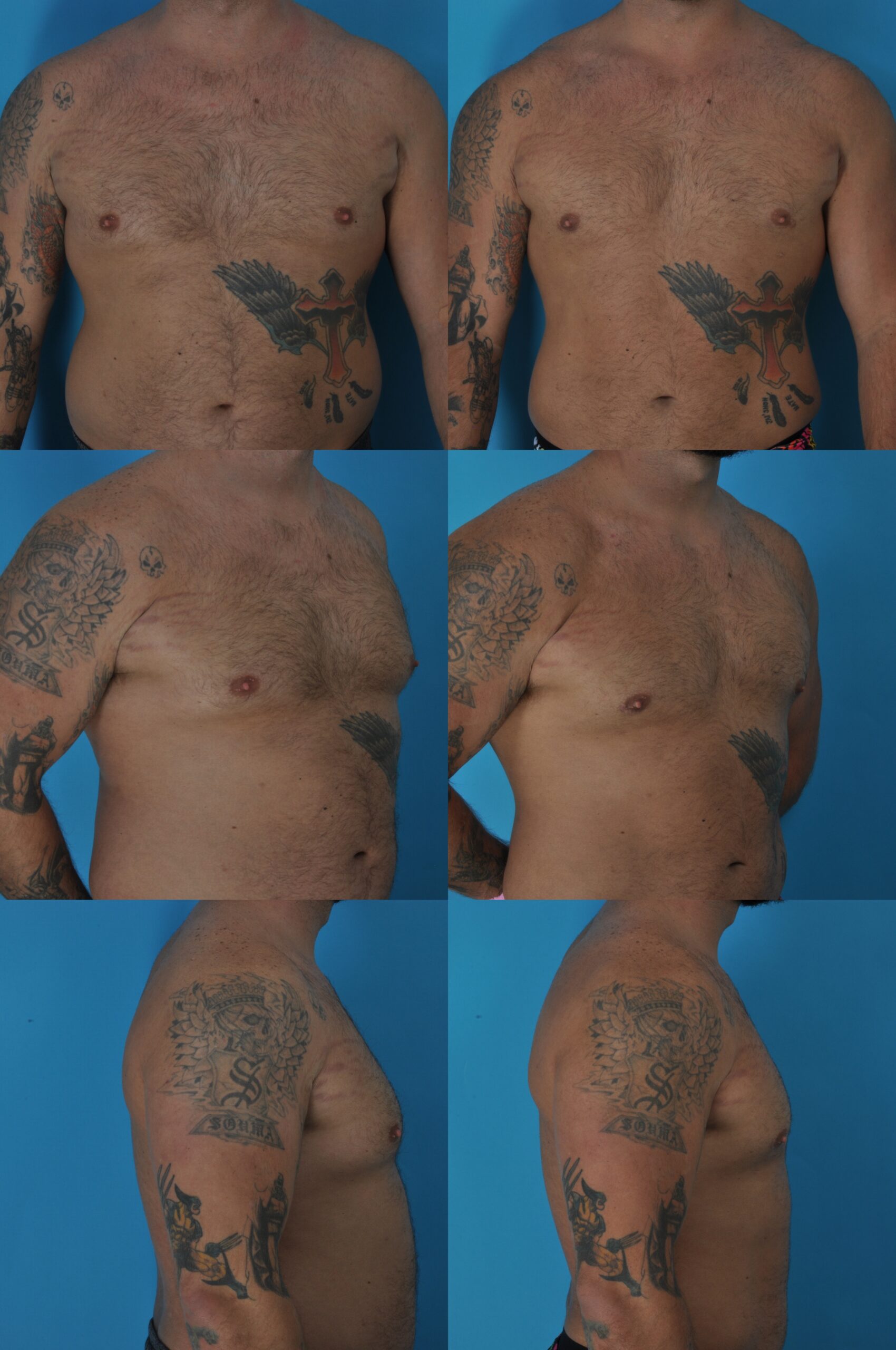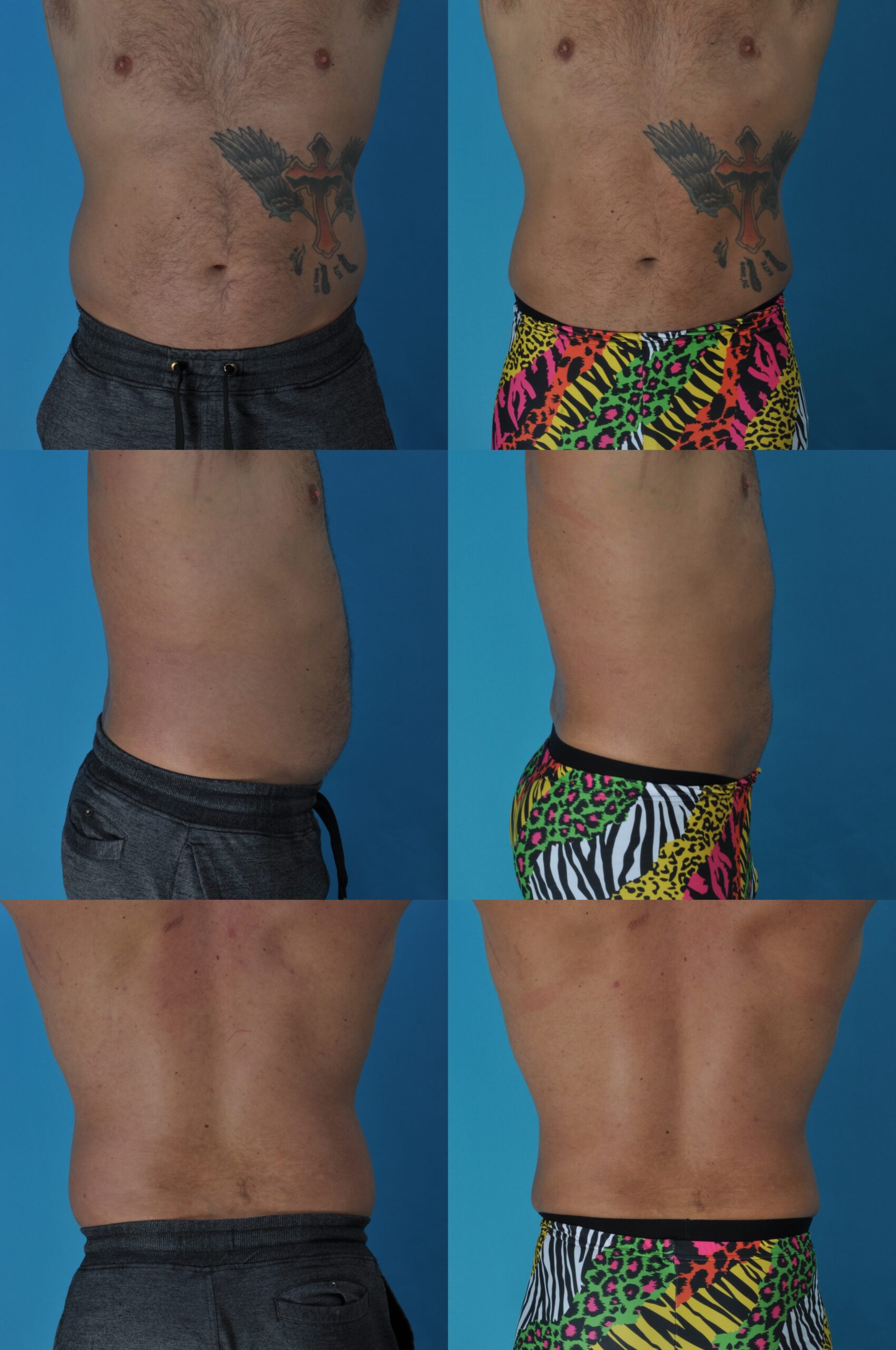INTRODUCTION
We tend to think of breast reduction as a female procedure, but many men also opt to have their breasts reduced. “Gynecomastia” is the term for enlargement of male breasts. It is a common condition, affecting about one-third of males overall, and an even larger percentage of adolescent boys and men over 65.
What Causes Breast Enlargement in Men?
Most of the time, there is no known cause. The problem is cosmetic. Men feel self-conscious without a shirt, and in severe cases, even with a shirt on. Gynecomastia can start with puberty, resolving on its own in most cases, or develop in older men as the balance of circulating testosterone and estrogen shifts toward the latter.
Sometimes gynecomastia may be caused by a specific drug or medical problem. Chronic alcoholics and men who use anabolic steroids as part of a bodybuilding program are more likely to develop this condition. Certain hormonal abnormalities, inherited or acquired, usually involving either a deficiency of testosterone or excess of estrogen, can cause breast enlargement. Hyperthyroidism can cause it too. Marijuana and cancer chemotherapeutic agents can bring it on. Gynecomastia can also be a side effect of a number of heart and blood pressure medications. In rare cases it may be associated with an estrogen-producing testicular tumor. If one of these medical conditions is suspected, the patient is referred to another specialist for investigation. Usually insurance companies regard this condition as cosmetic.
Most commonly, there is no underlying hormonal imbalance and no medical cause. Gynecomastia is seen predominantly in two age groups: (1) young men, whose pubertal breast bud development did not go away, and (2) men aged 50 and over, when breast development can occur due to hormonal changes. Excess breast tissue is unresponsive to diet and exercise. Although cosmetic, the problem is not trivial. Men have told me, “This makes me feel like I’m a woman,” even one memorable heavily-tattooed patient of mine who competes as an ultimate fighter. Another patient, a successful trial attorney in his early 60s, told me after surgery, “For the first time in my life, I feel normal.” He said he thought his breast problem had made him try to overcompensate by being aggressive professionally. One young man told me he faked hydrophobia as a teenager, even to the point of seeing a psychiatrist, so he would not have to take off his shirt for swimming classes in high school. Another told me no one had seen him without his shirt off since he was 15, including his fiancée. The psychological implications of this eminently correctable problem can be profound.
PHOTOS OF PATIENTS WITH MALE BREAST REDUCTIONS
R.B., Age 18
Procedure: Direct tissue excision and liposuction of chest and axillae
Before, 6 months
J.H., Age 24
Procedure: Direct tissue excision and liposuction of chest and axillae
Before, 3 months
J.S., Age 29
Procedure: Liposuction of abdomen, flanks, and chest, and subcutaneous mastectomies.
Second procedure 6 months later: Touchup liposuction of abdomen and flanks and right breast.
3 months after touchup
D.S., Age 36
Procedure: Direct tissue excision and liposuction of chest, abdomen and flanks.
Before, 6 weeks
E.W., Age 37
Procedure: Secondary direct tissue excision, liposuction of abdomen, flanks and breasts.
Before, 11 months after
P.T., Age 38
Procedure: Direct tissue excision and liposuction of chest
Before, 3 months
M.H., 40
Procedure: Direct tissue excision and liposuction of chest
Before, 3 months
M.J., Age 42
Procedure: Direct tissue excision and liposuction of chest, abdomen, flanks, and axillae. This patient underwent addition liposuction of his abdomen, flanks and chest 5 month later.
Before, 13 months after original procedure
There are two treatments:
- Liposuction. Excess fat is suctioned from the breasts, a familiar technique.
- Excision of Breast Tissue. Breast tissue is excised using an incision along the lower margin of the areola for access. This operation has the awkward and unnecessarily alarming name “subcutaneous mastectomies.” Often, liposuction is performed simultaneously to remove fatty tissue of the breast and its lateral extension below the armpit, and to smooth the contours.
Liposuction Alone
Liposuction alone may be used to treat breasts that are primarily fatty in consistency. Often liposuction of the breasts is performed at the same time as liposuction of the abdomen and flanks. In fact, one-third of men in my practice who have liposuction of the abdomen and flanks decide to have their breasts treated too. They say, “While I’m there, let’s get it done.”
Liposuction is not very effective in removing breast tissue itself. Consequently, only about half of the overall breast volume (the fatty component) may be removed using liposuction on its own, and less in young men who have firmer breasts (i.e., more breast tissue, less fat). If a 50% reduction is acceptable to the patient, liposuction alone is the procedure of choice. This includes most older men whose priority is their abdomen and flanks, and some reduction of the breasts is a bonus. Men who want a more dramatic reduction, or whose excess breast tissue is a priority, need to consider another option—direct excision.
Male Breast Reduction (Excision of Breast Tissue)
Breast tissue itself is difficult to remove by liposuction alone because it is a denser tissue type than fat. Young men with firm breasts or patients who desire a dramatic change in profile (i.e., a flat chest) and bodybuilders who want to emphasize their pectoral muscles are better served by direct excision (subcutaneous mastectomies). Liposuction is usually done at the same time to remove the fatty component and also to treat the axillary areas where there is often a fat roll extending around the chest wall on either side.
When breast tissue is excised, a longer incision is needed to allow enough room for the surgeon to insert scissors to cut out excess breast tissue. The “periareolar” incision follows the lower border of the areola, where it is well concealed in this natural boundary. A separate small incision in the inframammary crease is used for simultaneous liposuction (this is the only incision used when liposuction is done alone). This inframammary incision serves dual purpose as an opening for the drain, which is secured with a suture at this site until it is removed a few days after surgery. The periareolar incision is closed in layers using deep absorbable sutures and a running Prolene nonabsorbable suture in the skin. This suture is removed about a week after surgery.
It is important to note that subcutaneous mastectomies remove breast tissue, not skin. If the breasts are particularly large and the skin loose (which may happen after massive weight loss), it may be necessary to remove skin at the same time as breast tissue. While this is done commonly in women as part of a breast reduction, skin removal is usually not required in men. Although the skin may not be as tight as we’d like, it contracts to some extent, and the result is usually acceptable and avoids the additional scarring that would result from a skin excisional procedure.
While breast reduction scars are concealed by a bikini top in women, breast scars are not so easily hidden in men when they go shirtless. Ideally, the surgery should allow a man to expose his chest without feeling self-conscious. Therefore, the scars need to be kept to a minimum so as not to exchange one cosmetic flaw for another.
Occasionally the surgeon has no choice—there is simply too much skin and an operation resembling the female breast reduction (but without leaving much breast tissue behind, so the chest is almost flat) is undertaken. Patients are happy to be rid of the unwanted breast tissue and loose skin, but they may not be comfortable without a shirt because of the scars. Fortunately, a skin-excisional procedure is seldom needed in men, and when it is done, these men are very happy to be rid of their “man boobs”— the scars are an acceptable trade-off.
Liposuction of the breasts is remarkably safe. Infection is very unusual, similar to liposuction of other areas of the body. Occasionally a hypertrophic scar may form that can be revised to make it less noticeable.
Because subcutaneous mastectomies involve sharp dissection of breast tissues and creation of a pocket (unfortunately named “dead space”) where fluid can collect, a hematoma is a possibility. Any increased swelling, pain, and bruising on one side may signal a hematoma, which requires urgent surgical treatment—evacuation of the blood clot and cautery if there is a bleeding vessel.
Surface irregularities can occur. These may respond to a touch-up liposuction or sometimes to fat injection to treat a depression. It is important to leave a cushion of breast tissue under the nipple to avoid a saucer-like depression, which can be difficult to correct. This problem is seen frequently in patients who have been treated by non-plastic surgeons, operators who may not be aware that over excision produces this deformity. Even in lean males, there is a small amount of breast tissue that must be preserved.
- A small amount of bloody drainage on the dressing is normal.
- The dressing is removed on the day after surgery. You can then bathe and shower when you return home. There are semitransparent adhesive tape (Steri-Strips) on the incisions. These tapes usually stay on for several days. If one is starting to peel off, go ahead and trim it or remove it. Avoid strenuous activities for 2 weeks after surgery. Avoid any heavy lifting for 2 weeks. This helps prevent excessive swelling.
- Most patients are able to return to work within a week after surgery. If your work is physical you will require 2 weeks off.
- Strenuous exercise (examples: running, aerobics, tennis) should be avoided for 3 weeks. However, gentler exercise such as walking can be resumed 1 week after surgery. You may return to unrestricted activity 1 month after surgery. Your body will tell you—if your breasts are sore you are probably overdoing it.
- Once the tapes are removed, apply antibiotic ointment to the incisions, particularly any areas of crusting, twice daily. The crusts gradually come off on their own.
- Bruising is normal and usually goes away within a few weeks. It extends to the sides and abdomen because of gravity. Swelling is also to be expected and takes a month or two to resolve.
- Notify the office immediately if one breast appears to be getting much larger than the other. This could signal a hematoma, which requires prompt surgical attention.
- After excisional surgery, you may wake up wearing a compression garment with Velcro straps on your chest. This can be replaced with a less cumbersome garment that provides gentle compression of the chest, such as a tight-fitting athletic shirt (Under Armour is one brand). Usually this is done after the drains come out. The garment helps limit swelling, and most patients feel more comfortable wearing it. Most patients wear such a garment for 3-4 weeks and later while exercising.
Q: What will I look like after surgery?
A: You do not see your final result right away, of course. It takes a few
months for the swelling to fully go down. However, most patients notice a
difference when the dressings come off the day after surgery, even with
swelling. It takes about 3 months for the swelling to do down completely.
Q: Is it painful?
A: The surgery is not particularly painful. In fact, the breasts are numb after
surgery. Gradually, the feeling returns.
Q: Are there any side effects from this surgery?
A: Skin response is variable and depends on your age, skin elasticity, weight
loss, and the amount of breast tissue. There may be some loose skin causing
skin folds afterward. It is possible to overresect breast tissue, leaving a
concavity, although this is unusual if the operator is an experienced plastic
surgeon. Contour irregularities sometimes develop, and a touch-up
procedure such as a touch-up liposuction or fat injection may be needed
later.
Q: How much work will I miss?
A: Most men are able to return to work within a week, some in just a few
days if their job is not physical, and they are no longer taking prescription
pain killers. You need 2 weeks off if you have a physical job.
Q: Can this condition recur?
A: The fat and breast tissue that are removed at surgery are gone forever, and
your breasts will always be less full than they would have been without the
surgery. However, it is possible that the breast tissue that is left behind
might enlarge (“hypertrophy”) and require retreatment, but this is unusual
in the absence of a medical condition, medications, or steroids that might
stimulate breast tissue development.
Q: How long does the surgery take?
A: The actual surgery takes about 30 minutes for liposuction alone, or an
hour and a half for the combined procedure-subcutaneous mastectomies
and liposuction.


